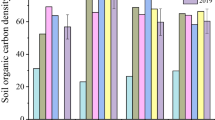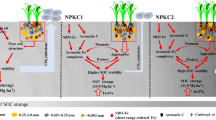Abstract
Spatial variation of dissolved organic carbon (DOC) in soils of riparian wetlands and responses to hydro-geomorphologic changes in the Sanjiang Plain were analyzed through in situ collecting soil samples in the Naoli River and the Bielahong River. The results showed that the average contents of DOC for soil layer of 0–100 cm were 730.6 mg/kg, 250.9 mg/kg, 423.0 mg/kg and 333.1 mg/kg respectively from riverbed to river terrace along the transverse directions of the Naoli watershed. The content of the soil DOC was the highest in the riverbed, lower in the high floodplain and much lower in the river terrace, and it was the lowest in the low floodplain. The difference in the content and vertical distribution of DOC between the riverbed and the three riparian wetlands was significant, while it was not significant among the low floodplain, the high floodplain and the river terrace. The variability of soil DOC was related to the hydrological connectivity between different landscape position of the riparian wetlands and the adjacent stream. Extremely significant correlations were observed between DOC and total organic carbon (TOC), total iron (TFe), ferrous iron (Fe(II)) whose correlation coefficients were 0.819, −0.544 and −0.709 in riparian wetlands of the Naoli River. With the increase of wetland destruction, soil pH increased and soil DOC content changed. The correlation coefficients between soil DOC and TOC, TFe, Fe(II) also changed into 0.759, −0.686 and −0.575 respectively in the Bielahong River. Under the impact of drainage ditches, the correlations between soil DOC and TFe, Fe(II) were not obvious, while the soil pH was weakly alkaline and was negatively correlated with soil DOC in the previous high floodplain. It indicates that riparian hydro-geomorphology is the main factor that could well explain this spatial variability of soil DOC, and the agricultural environmental hydraulic works like ditching also must be considered.
Similar content being viewed by others
References
Aguilar J B, Luster J, Shrestha P A et al., 2012. Analysis of carbon and nitrogen dynamics in riparian soils: model validation and sensitivity to environmental controls. Science of the Total Environment, 429(1): 246–256. doi:10.1016/j.scitotenv.2012.04.026
Anne-Catherine P W, Gerard G, Emilie J et al., 2011. Development of a combined isotopic and mass-balance approach to determine dissolved organic carbon sources in eutrophic reservoirs. Chemosphere, 83(3): 356–366. doi:10.1016/j.chemosphere.2010.12.014
Billings W D, 1987. Carbon balance of Alaskan tundra and taiga ecosystems: past, present and future. Quaternary Science Reviews, 6(2): 165–177. doi: 10.1016/0277-3791(87)90032-1
Chen D J Z, MacQuarrie K T B, 2004. Numerical simulation of organic carbon, nitrate, and nitrogen isotope behavior during denitrification in a riparian zone. Journal of Hydrology, 293: 235–254. doi:10.1016/j.jhydrol.2004.02.002
Coletti J Z, Hinz C, Vogwill R et al., 2013. Hydrological controls on carbon metabolism in wetlands. Ecological Modeling, 249: 3–18. doi:10.1016/j.ecolmodel.2012.07.010
Glatzel S, Kalbitz K, Dalva M et al., 2003. Dissolved organic matter properties and their relationship to carbon dioxide efflux from restored peat bogs. Geoderma, 113(3–4): 397–411. doi: 10.1016/S0016-7061(02)00372-5
Huo Lili, Zou Yuanchun, Guo Jiawei et al., 2013. Effect of reclamation on the vertical distribution of SOC and retention of DOC. Environmental Science, 34(1): 283–287. (in Chinese)
Jacinthe P A, Groffman P M, Gold A J, 2003. Dissolved organic carbon dynamics in a riparian aquifer: effects of hydrology and nitrate enrichment. Journal of Environmental Quality, 32(4): 1365–1374. doi:10.2134/jeq2003.1365
Jencso K G, McGlynn B L, Gooseff M N et al., 2009. Hydrologic connectivity between landscapes and streams: transferring reach- and plot-scale understanding to the catchment scale. Water Resources Research, 45(4): W04428. doi:10.1029/2008WR007225.
Jiang Ming, 2007. Transfer and Transformation of Iron and Its Environmental Indication of Wetland Soil under Different Hydrogeomorphology Conditions in the Sanjiang Plain. Changchun: Northeast Institute of Geography and Agricultural Ecology, Chinese Academy of Sciences. (in Chinese)
Jiang Ming, Lu Xianguo, Wang Hongqing et al., 2011. Transfer and transformation of soil iron and implications for hydrogeomorpholocial changes in Naoli River catchment, Sanjiang Plain, Northeast China. Chinese Geograhpical Science, 21(2): 149–158. doi: 10.1007/s11769-011-0454-4
Kong Fanlong, Xi Min, Lu Xianguo et al., 2013. Spatial and temporal variation of dissolved organic carbon in soils of annular wetlands in Sanjiang Plain, China. Acta Pedologica Sinica, 50(7): 847–852. (in Chinese)
Lan Jiacheng, Fu Wali, Duan Zhengfeng et al., 2011. Response of soil dissolved organic carbon to the land use and the relations with soil nutrients in Karst Area. Research of Soil and Water Conservation, 18(5): 76–80, 86. (in Chinese)
Li Rui, Qu Ming, 2004. Effects of dissolved organic matter on environment. Ecology and Environment, 13(2): 271–275. (in Chinese)
Li Zhongpei, Zhang Taolin, Chen Biyun, 2004. Dynamics of soluble organic carbon and its relation to mineralization of soil organic carbon. Acta Pedologica Sinica, 41(4): 544–552. (in Chinese)
Liu M, Zhang Z J, He Q et al., 2014. Exogenous phosphorus inputs alter complexity of soil-dissolved organic carbon in agricultural riparian wetlands. Chemosphere, 95: 572–580. doi:10.1016/j.chemosphere.2013.09.117
Montreuil O, Cudennec C, Merot P, 2011. Contrasting behaviour of two riparian wetlands in relation to their location in the hydrographic network. Journal of Hydrology, 406: 39–53. doi:10.1016/j.jhydrol.2011.05.049
Müller M, Alewell C, Hagedorn F, 2009. Effective retention of litter derived dissolved organic carbon in organic layers. Soil Biology and Biochemistry, 41(6): 1066–1074. doi:10.1016/j.soilbio.2009.02.007
Rosenqvist L, Kleja D B, Johansson M B, 2010. Concentrations and fluxes of dissolved organic carbon and nitrogen in a Picea abies chronosequence on former arable land in Sweden. Forest Ecology and Management, 259(3): 275–285. doi:10.1016/j.foreco.2009.10.013
Schulze K, Borken W, Matzner E, 2010. Dynamics of dissolved organic 14C in throughfall and soil solution of a Norway spruce forest. Biogeochemistry, 106(3): 461–473. doi: 10.1007/s10533-010-9526-2
Song C C, Wang L L, Guo Y D et al., 2011. Impacts of natural wetland degradation on dissolved carbon dynamics in the Sanjiang Plain, Northeastern China. Journal of Hydrology, 398: 26–32. doi:10.1016/j.jhydrol.2010.11.029
Song Changchun, Wang Yiyong, Wang Yuesi et al., 2003. Carbon dynamics of wetland in the Sanjiang Plain. Chinese Geograhpical Science, 13(3): 228–231. doi: 10.1007/s11769-003-0021-8
Tao S, Lin B, 2000. Water soluble organic carbon and its measurement in soil and sediment. Water Resources, 34(5): 1751–1755. doi: 10.1016/S0043-1354(99)00324-3
Tao Xiao, Zhao Hongfei, Xu Xiaoniu, 2011. Changing regularity of dissolved organic carbon in soil under different types of urban green space in Hefei. Journal of Northeast Forestry University, 39(12): 63–66. (in Chinese)
Terajima T, Moriizumi M, 2013. Temporal and spatial changes in dissolved organic carbon concentration and fluorescence intensity of fulvic acid like materials in mountainous headwater catchments. Journal of Hydrology, 479: 1–12. doi:10.1016/j.jhydrol.2012.10.023
Turner E K, Worrall F, Burt T P, 2013. The effect of drain blocking on the dissolved organic carbon (DOC) budget of an upland peat catchment in the UK. Journal of Hydrology, 479: 169–179. doi:10.1016/j.jhydrol.2012.11.059
Wallage Z E, Holden J, McDonald A T, 2006. Drain blocking: an effective treatment for reducing dissolved organic carbon loss and water discolouration in a drained peatland. Science of the Total Environment, 367(2–3): 811–821. doi: 10.1016/j.scitotenv.2006.02.010
Wang L L, Song C C, Song Y Y et al., 2010. Effects of reclamation of natural wetlands to a rice paddy on dissolved carbon dynamics in the Sanjiang Plain, northeastern China. Ecological Engineering, 36(10): 1417–1423. doi:10.1016/j.ecoleng.2010.06.021
Worrall F, Gibson H S, Burt T P, 2007. Modelling the impact of drainage and drain-blocking on dissolved organic carbon release from peatlands. Journal of Hydrology, 338: 15–27. doi:10.1016/j.jhydrol.2007.02.016
Wu Jianmin, Xi Min, Kong Fanlong et al., 2013. Review of researches on the factors influencing the dynamics of dissolved organic carbon in the soils. Geological Review, 59(5): 953–961. (in Chinese)
Xi M, Lu X G, Li Y et al., 2007. Distribution characteristics of dissolved organic carbon in annular wetland soil-water solutions through soil profiles in the Sanjiang Plain, Northeast China. Journal of Environmental Sciences, 19(9): 1074–1078. doi: 10.1016/S1001-0742(07)60175-2
Xi Min, Lu Xianguo, 2007. Distribution characteristics of dissolved organic carbon in the sediment of multistage canal and ditch systems in wetlands of the Sanjiang Plain. Acta Ecologica Sinica, 27(4): 1434–1441. (in Chinese)
Zhang Guilan, 2010. Changes of soil labile organic carbon in different land uses in Sanjiang Plain, Heilongjiang Province. Chinese Geographical Science, 20(3): 139–143. doi: 10.1007/s11769-010-0139-4
Zhang Na, Zhang Xinyu, Gao Lupeng, 2009. Overview on the increasing trends and their Influencing factors of long-term monitoring of water dissolved organic carbon. Research of Soil and Water Conservation, 16(3): 286–290. (in Chinese)
Zhang Yangzhen, 1988. Occurrence, character and classification of marsh soil in Sanjiang Plain. In: Huang Xichou (ed.). Marsh Study of China. Beijing: Science Press, 135–144. (in Chinese)
Zheng Taihui, Chi Guangyu, Shi Yi et al., 2010. Effects of reclamation on soil iron activity in Bielahong River Basin. Journal of Agro-Environment Science, 29(supp.): 89–92. (in Chinese)
Author information
Authors and Affiliations
Corresponding author
Additional information
Foundation item: Under the auspices of National Natural Science Foundation of China (No. 41101080, 41171047), Natural Science Foundation of Shandong Province (No. ZR2014DQ028)
Rights and permissions
About this article
Cite this article
Xi, M., Kong, F., Lyu, X. et al. Spatial variation of dissolved organic carbon in soils of riparian wetlands and responses to hydro-geomorphologic changes in Sanjiang Plain, China. Chin. Geogr. Sci. 25, 174–183 (2015). https://doi.org/10.1007/s11769-015-0744-3
Received:
Accepted:
Published:
Issue Date:
DOI: https://doi.org/10.1007/s11769-015-0744-3




